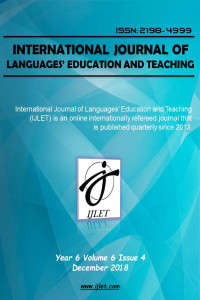Öz
13. Yüzyılın Türkçeyi en güzel, en sade ve en akıcı kullanan şairlerinden olan Yunus Emre, zengin şiir dünyasını imge ve metaforlarla süslemiştir. Onun şiirleri iki belki üç katmanlı olarak düşünülebilir. Çünkü o aslında, tek bir beyitiyle, farklı okuyucu kitlelerine aynı düşünceyi anlatmayı başarabilmiştir. Bunu yaparken metaforlara başvurmuştur. Bilindiği gibi metafor “bir duygu ve düşünceyi” fiziksel dünyada sıklıkla kullanılan başka bir şeyle benzetme yönünü kullanarak yapılan bir zihinsel sürecin dildeki yansımasıdır. Metot olarak basit bir benzetmenin ötesinde, benzeyen ile benzetilen ve anlatılmak istenen arasındaki üçlü ilişkiyi hedef ve kaynak üzerinden açıklar. Yunus Emre’nin basit metaforlarla anlattığı derin düşünceleri vardır. Basit metaforlar, onun şiirinin yüzey katmanını oluştururken bu metaforların altında derin ve sistemli bir tasavvuf anlayışı görülmektedir. Yunus Emre’nin şiirlerinde metafor dünyası öylesine zengindir ki neredeyse metafor kullanmadığı tek beyiti yok gibidir. Onun şiirini, metaforlar kullandığı tüm metaforlar açısından incelemek ayrı ve daha kapsamlı bir çalışmanın konusudur. Ancak bu çalışmada Yunus Emre’nin Divanı’nda ticaretle ilgili metaforlara değinilmiş ve bu konuyla ilgili metaforları kullanmasının sebepleri üzerinde durulmuştur. Yunus Emre’nin sufi bir şair olarak yöntem açısından kendisine Kur’an-ı Kerim’i seçtiği söylenebilir. Çünkü Allah, Kur’an-ı Kerim de herkesin anlayabilmesi için basit metaforlarla kullarına seslenmektedir. Örneğin cehennem’i ateş, cennet’i bahçe, günahkarları ahireti satan metaforlarıyla verir. Kur’an-ı Kerim’de pek çok ayette ticaretle ilgili metaforlara başvurulmuştur. İşte Yunus Emre de kendisine rehber edindiği kutsal kitabından esinlenmiş, hemen hemen aynı metaforları şiirlerinde kullanmıştır. Aslında onun şiirleri metot olarak bu benzerliğin yanında Allah’ın ayetlerinin kendi dilince, şair üslubunu da katarak terennüm etmesinden başka bir şey değildir. Satıcı, dükkan, pazar, iflas eden tüccar gibi pek çok metaforu bu dünya ve öbür dünyayı, günahı ve sevabı, cenneti ve cehennemi karşılaştırırken şiirsel bir üslup ve eşsiz bir söyleyiş kolaylığı ile kullanır.
Anahtar Kelimeler
Kaynakça
- KEMAL YUNUSOĞLU, M. (2015). Yönelim Metaforları ve Kültürel Temelleri, Turkish Studies Vol. 10/8, 1627-1642.
- TATÇI, M. (1990), Yunus Emre Divanı I (İnceleme) , Kültür Bakanlığı Yay. Ankara.
- TATÇI, M. (1990), Yunus Emre Divanı II(Tenkitli Metin), Kültür Bakanlığı Yay. Ankara.
- TİMURTAŞ, F. K. (1982), “Yunus’un Dili Üzerine Notlar”, II. Milletlerarası Türk Folklor Kongresi Bildirileri, Ankara: s.405-412.
- TİMURTAŞ, F. K. (1989), Yunus Emre Divanı, Ankara: Kültür Bakanlığı Yay.
Öz
Yunus Emre, one of those poets that used the Turkish Language on the simplest and the most fluid way, had adorned his rich poetry world with images and metaphors. His poems can be considered two, or perhaps, three-stage. He could explain the same thought, through his one beyit/verse, to the different readers. On this way, he had used methapors. As known, the methapor is to use analogy when we want to liken or compare any sense or thought with something else. In term of method, beyond a simple likening, it explains the relations between “alike, “similar” and “context” by the way of “target” and “domain”. Yunus Emre has depp thoughts which he explaine them by the simple methapors. These simple methapors form the the exterior face of his poetry, meanwhile, there are a deep and systematic perception of the Sufism. The methapor world in Yunus’s poetry is so rich that we can’t find any beyit/verse without methapor. Thus, to study his poems in term of all methapors he used, is another wide subject. In this study, we deal with the commercial methapors in his Diwan and we concentrate on the reasons of his use those methapors. It can be said that Yunus Emre, as a sûfî poet, had chosen for himself the Holy Koran, in term of method. Because Allah, adress in the Koran to his all subjects with the simple methapors in order to be understood. For example, He denots “the eden” by “garden; “the hell” by “fire” and “the sinners” by “who sold the hereafter”. There are also in the Koran many methapors about commerce. Thus, Yunus Emre was influenced by the Koran which he took it as his guide and, almost, used the same methapors in his poetry. Indeed, his poems, besides this similarity in term of method, are only to chant teh verses of Allah by his private way, adding poetic style. He uses all of methapores successfully and in a uniqe style when he cites a lot of methapores such as seller, store, market, the merchant who bankrupted; also when he compares eden with hell, hereafter with this world and sin with divine reward.
Anahtar Kelimeler
Kaynakça
- KEMAL YUNUSOĞLU, M. (2015). Yönelim Metaforları ve Kültürel Temelleri, Turkish Studies Vol. 10/8, 1627-1642.
- TATÇI, M. (1990), Yunus Emre Divanı I (İnceleme) , Kültür Bakanlığı Yay. Ankara.
- TATÇI, M. (1990), Yunus Emre Divanı II(Tenkitli Metin), Kültür Bakanlığı Yay. Ankara.
- TİMURTAŞ, F. K. (1982), “Yunus’un Dili Üzerine Notlar”, II. Milletlerarası Türk Folklor Kongresi Bildirileri, Ankara: s.405-412.
- TİMURTAŞ, F. K. (1989), Yunus Emre Divanı, Ankara: Kültür Bakanlığı Yay.
Ayrıntılar
| Birincil Dil | Türkçe |
|---|---|
| Konular | Türk Dili ve Edebiyatı (Diğer) |
| Bölüm | Araştırma Makalesi |
| Yazarlar | |
| Yayımlanma Tarihi | 30 Aralık 2018 |
| Yayımlandığı Sayı | Yıl 2018 Cilt: 6 Sayı: 4 |

